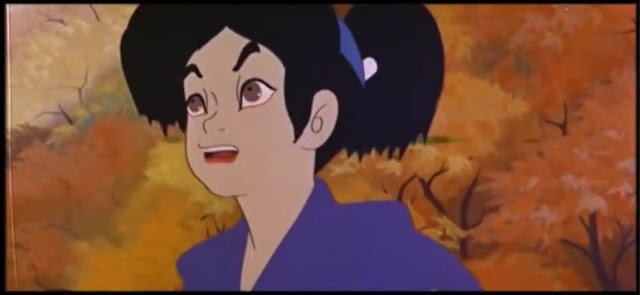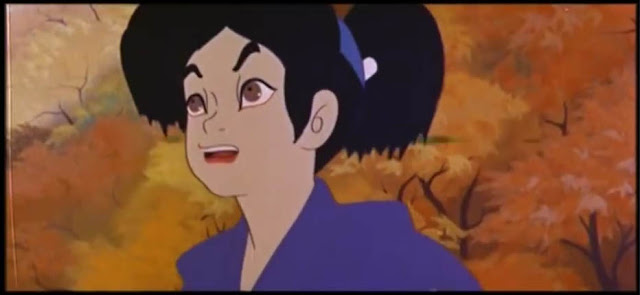And even as you are reading this weblog, chances are high the assemble of motion photos you adore
reach from
and are challenging! And chances are high also that even as you were a kid within the 60s or
even the 70s or the 80s, you maybe can also wish had the possibility to gaze a Japanese
challenging movie for your local drive-in or at a kiddy matinee, lengthy sooner than Akira
and Totoro would worth-team the arthouse cinemas of
and flip “cartoons” into “animation.” We’re speaking aid within the
day here, lengthy sooner than Japanese animation became as soon as viewed as a viable entertainment
medium, methodology sooner than someone realized that “Annie Can also” became as soon as anything else diverse than
maybe the title of the monumental-haired girl selling tickets within the sector quandary of work.
And adore any expansive journeys this one begins with a ninja. Magic
Boy (Shonen Sarutobi Sasuke, 1959) ceaselessly is the first Japanese challenging movie to
compile North American theatrical unlock, screening in June of ‘61 courtesy
The ninja magic of Magic Boy became as soon as followed very closely by Globe Photos’ American
unlock of Toei’s Panda And The Magic Serpent (Hakujaden). This movie premiered
in
sooner than Magic Boy, making it the first color Japanese challenging movie. Panda,
directed by Taiji “Jack & The Witch” Yabushita, at one level became as soon as broadly
on hand by means of poorly transferred public enviornment VHS. 60s The United States became as soon as stuffed with
Japanese imports; no longer only transistor radios taking part in Kyu Sakamoto’s
“Sukiyaki”, nonetheless anime characteristic films adore Alakazam The Powerful, The
Littlest Warrior, Small Prince &
The Eight Headed Dragon, and Gulliver’s Travels Beyond The Moon would enthrall
younger folks at matinees and within the playgrounds of drive-in theaters.
 |
| lobby playing cards, print adverts, & LPs for Alakazam, Panda, and others |
Once the Seventies got entertaining,
hunger for astronomical-budgeted younger folks’s animation capabilities would be replaced by
hunger for TV reveals starring without considerations marketable toy robots, Ultramen, and Masked
Riders. Fewer challenging films were made in
and in consequence fewer made their methodology across the pond to entertain and mystify
us.
 |
| poster and lobby playing cards for No one’s Boy |
Indubitably any such stragglers became as soon as Yugo Serikawa’s Chibikko Remi to
Meiken Kapi (Small Remi and Capi, The Notorious Canines), the first anime adaptation
of Hector “Perrine Epic” Malot’s original Sans Famille. This 1970 Toei
unlock affects a jarring, very dated 1960 visible kind. Under the title No one’s Boy, the movie
wouldn’t compile it into American theaters till the early 1980s, courtesy
“Malijack Productions” and an English dub starring Jim “Thurston
Howell
later appear on cable TV and within the younger folks’s video sections of video condo
retail outlets within the
and
The fairy sage Jack And The Beanstalk will seemingly be an worn story,
nonetheless even as you set a director adore Gisaburo Sugii accountable, issues are hump to
compile surreal, and that’s exactly what occurs in this 1974 characteristic. Nippon
Herald’s Jack didn’t deserve to aid a decade nonetheless made it to US cinemas within the
year of its unlock by means of Columbia Photos. Mixing European and Japanese
animation styles, it sidesteps cliches and winds up a thoughtful, a minute bit
eerie movie, fully storybook-enabled for the younger folks, but unearthly and visually
dynamic ample to entertain adults.
 |
| newspaper advert from Seattle Instances, June 1980 |
1980 would be an virtually unheralded turning level within the
world of anime localization; Roger Corman’s Contemporary World Photos would unlock
Toei’s 1979 Galaxy Explicit 999 movie in theaters across
For the first time, a most traditional Japanese
property would be dropped on the States about a months after its Japanese unlock
and marketed no longer as a younger folks’s image nonetheless a science-fiction whisk on the
stage of Smartly-known person Wars. Here’s the assemble of simultaneous, skilled, serious
anime unlock we’ve reach to seize as a correct here within the contemporary world, nonetheless in
1980 this methodology simply hadn’t took place sooner than.
 |
| Experiences are kinda harsh |
 |
| Assassinate no longer confuse “Galaxy Explicit” with “Uninteresting night Explicit.” Belief me. |
Without a doubt the
Galaxy Explicit would be problematic; edits for time would chop half an hour out
of Tetsuro Hoshino’s whisk to the Mechanized Planet, and celeb
impersonation bellow acting made Captain Harlock’s appearance less impressive
than it would possibly most likely maybe in every other case were. It became as soon as 1980, folks still didn’t seize
Japanese animation very seriously. But, and this is the most indispensable section, they
were taking it more seriously than they had been. Galaxy Explicit would cloak
across
with trailers, radio spots, posters and TV adverts marketing Leiji Matsumoto’s
Rin Taro-directed set delusion to a nation impartial awakening to the possibility of
Japanese set cartoons. The movie would seem put up-cinema on cable TV and
enact its existence cycle within the shelves of dwelling video retail outlets with a VHS unlock,
lodging deep within the recollections of younger viewers who would wrestle years later to
recall the title of “that comic strip with the educate in set.”
5 years later, within the center of releasing gemstones adore Situation
Raiders, Deathstalker, and C.H.U.D.,
but one more prestigious Japanese anime unlock, Tokuma Shoten/High Craft’s Nausicaa,
directed by some guy named Hayao Miyazaki. A unique science-delusion vision of
ecological destruction, the movie became as soon as an instantaneous classic and attach aside
on the plan as
top anime director.
over again cutting thirty minutes, dumbing down the dialogue, and constructing new
poster art work that break up the difference between Mad Max, Dune, and Smartly-known person Plod.
Accrued, we deserve to seize the horrible with the impartial, and Warriors would, adore Galaxy
Explicit sooner than it, be viewed on monitors across the
States
became as soon as highly efficient ample to withstand any amount of shoddy localization. Theater
patrons and later those who saw the movie on cable tv or condo VHS
couldn’t aid nonetheless be impressed by the movie, despite the indisputable truth that the predominant character became as soon as now
named “Zandra”, and its determined refusal to be a “younger folks’s
movie” makes it a milestone on American movie monitors.
 |
| Toronto Smartly-known person movie itemizing and VHS field art work for “Warriors” |
But became as soon as it? Had been
there earlier makes an attempt at releasing Japanese anime films geared against grownups in
Smartly, there became as soon as one. Possibly two. Osamu Tezuka’s Mushi Productions, to blame for
internationally a success reveals about robotic boys and speaking white lions, took
a giant gamble on characteristic animation for older audiences within the slow 60s. Their 1969
“Animerama” characteristic A Thousand And One Nights, in accordance to Sir Richard
Burton’s translation of the bawdy Arabic folk tales, is a who’s who of anime
ability adore Osamu Dezaki and Eichi Yamamoto, ensuing in a reasonably exciting
if meandering movie. Purportedly an English-dubbed version got a extraordinarily
miniature theatrical unlock in
nonetheless the top seemingly surviving evidence is the dubbed trailer.
 |
| from the English trailer for “A Thousand And One Nights” |
Mushi’s next characteristic, Seventies Cleopatra, became as soon as an indulgent
mess, a hodgepodge of peep gags, anachronisms, and Dame Oyaji and Sazae-San
cameos stuffed into the story of Antony, Cleopatra, and Caesar, all bookended
by a peculiar are living-motion/comic strip-head science-fiction subplot. A huge flop
in
movie became as soon as a crippling blow to Mushi’s funds; desperately they licensed the
movie to an American distributor, who released it with a self-imposed X rating
below the title “Cleopatra Queen Of Sex.” Now not like A Thousand And One Nights, evidence of
Cleopatra‘s American unlock does exist; no longer decrease than one screening of a subtitled
print took quandary at
Bijou in April of 1972. Diversity’s evaluation is no longer model, referencing a
“disconcerting clash of styles within the animation” and “an
overabundance of bawdy blue grossness”, remarking “it’s no longer easy to imagine
someone being enraged by the bare breasts of a comic strip character,” a sentiment
absolute self perception magnificent to this present day’s waifu-worshipping 2D adore slaves.
 |
| “Cleopatra, Queen Of Sex” |
The failure of Cleopatra and of its followup Belladonna Of
Sadness (which after most indispensable 2d look is getting a remastered theatrical unlock) would slide away challenging films for grownups within the fingers of Ralph
“Wizards” Bakshi and no subject Europeans were pondering when they made Tarzoon, Shame Of The Jungle. After Warriors Of The Wind blew away, there would be a
lengthy, darkish movie-home anime interregnum; determined, the stitched-collectively Robotech
The Film would swiftly appear, top seemingly to be hurriedly whisked away to a
unsafe break containment facility. It
would be slow 1989 sooner than Streamline Photos delivered Katsuhiro Otomo’s Akira
to American cinemas, making Japanese animation a power to be reckoned with wherever
on the Venn scheme movie snobs and animation nerds meet. This day new releases
of films by Mamoru Oshii or Mamoru Hosoda, Isao Takahata or Hayao “Long previous
Fishing”
explain up in towns with hip, with-it theaters.
Nonetheless, the decline of
the neighborhood video condo, no longer easy cases for movie theater owners,
the give map of bodily media, and the
whimsical unreliability of streaming video all herald a new and unsatisfying
era for the seeker of a minute bit nontraditional cinema. Will the local theater all over over again turn out to be our
window into the realm of non-Disney animation for adults and younger folks and adults
who recount adore younger folks? Will we ever return to the days of the double characteristic, the
all-night shockathon, the kiddy matinee, the hunger of an industry interested to
personal its monitors with darn shut to anything else that can match by means of the projector’s
vivid gate? Potentially no longer. Accrued, as
lengthy as popcorn pops in a lobby someplace, as lengthy as our feet still persist with
the flooring of our neighborhood movie home, we’ll incessantly remember hope.
 |
| let’s all slide to the lobby |
for their assistance.




